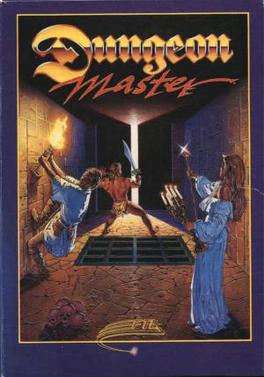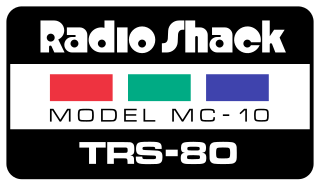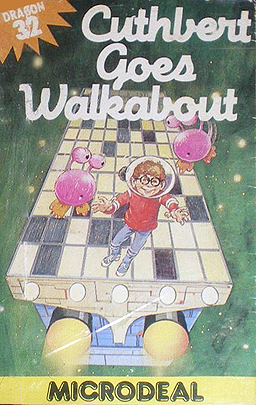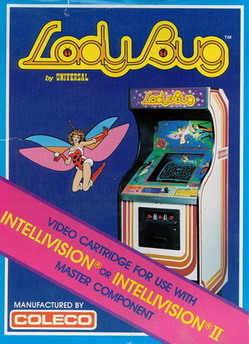
The TRS-80 Micro Computer System is a desktop microcomputer developed by American company Tandy Corporation and was sold through their Radio Shack stores. Launched in 1977, it is one of the earliest mass-produced and mass-marketed retail home computers. The name is an abbreviation of Tandy Radio Shack, Z80 [microprocessor], referring to its Zilog Z80 8-bit microprocessor.

The RadioShack TRS-80 Color Computer, later marketed as the Tandy Color Computer, is a series of home computers developed and sold by Tandy Corporation. Despite sharing a name with the earlier TRS-80, the Color Computer is a completely different system and a radical departure in design based on the Motorola 6809E processor rather than the Zilog Z80 of earlier models.

The Tandy 1000 was the first in a series of IBM PC compatible home computers produced by the Tandy Corporation, sold through its Radio Shack and Radio Shack Computer Center stores. Introduced in 1984, the Tandy 1000 line was designed to offer affordable yet capable systems for home computing and education. Tandy-specific features, such as enhanced graphics, sound, and a built-in joystick port, made the computers particularly attractive for home use.

Dungeon Master is a role-playing video game featuring a pseudo-3D first-person perspective. It was developed and published by FTL Games for the Atari ST in 1987, almost identical Amiga and PC (DOS) ports following in 1988 and 1992.

The TRS-80 MC-10 microcomputer is a lesser-known member of the TRS-80 line of home computers, produced by Tandy Corporation in the early 1980s and sold through their RadioShack chain of electronics stores. It was a low-cost alternative to Tandy's own TRS-80 Color Computer to compete with entry-level machines such as the VIC-20 and Sinclair ZX81.

Sword of Fargoal is a dungeon exploration video game developed by Jeff McCord and published by Epyx for the VIC-20 in 1982. It was later published for the Commodore 64 in 1983. The game was originally released on cassette tape and 5¼" floppy disk formats.

Temple of Apshai is a dungeon crawl role-playing video game developed and published by Automated Simulations in 1979. Originating on the TRS-80 and Commodore PET, it was followed by several updated versions for other computers between 1980 and 1986.
1980 saw the release of a number of games with influential concepts, including Pac-Man, Battlezone, Crazy Climber, Mystery House, Missile Command, Phoenix, Rally-X, Space Panic, Stratovox, Zork, Adventure, and Olympic Decathlon. The year's highest-grossing video game was Namco's arcade game Pac-Man, while the best-selling home system was Nintendo's Game & Watch. The Atari VCS also grew in popularity with a port of Space Invaders and support from new third-party developer Activision.

Phantom Slayer is a video game released by Med Systems in 1982 for the TRS-80 Color Computer and Dragon 32/64. Written by Ken Kalish, Phantom Slayer has been cited as an early forerunner of the modern first-person shooter genre.

Dung Beetles is an Apple II maze video game written by Bob Bishop published in 1982 by Datasoft. The gameplay is similar to Pac-Man, but a portion of the maze around the player-controlled character is enlarged as if being viewed through a square magnifying glass.

Cuthbert Goes Walkabout is a maze video game written by Steve Bak for the Dragon 32/64 and published by Microdeal in 1983. A TRS-80 Color Computer port was released in the same year. Versions for the Atari 8-bit computers and Commodore 64 followed in 1984. The game features the character Cuthbert. The game is based on the Konami arcade game Amidar.

Microdeal was a British software company which operated during the 1980s and early 1990s from its base at Truro Road in the town of St Austell, Cornwall. The company, founded by John Symes was one of the major producers of games and other software for the 8-bit home computers of the time, in particular the Dragon 32 and the similar Tandy TRS-80 Color Computer ("CoCo").

Telengard is a 1982 role-playing dungeon crawler video game developed by Daniel Lawrence and published by Avalon Hill. The player explores a dungeon, fights monsters with magic, and avoids traps in real-time without any set mission other than surviving. Lawrence first wrote the game as DND, a 1976 version of Dungeons & Dragons for the DECsystem-10 mainframe computer. He continued to develop DND at Purdue University as a hobby, rewrote the game for the PET 2001 after 1978, and ported it to Apple II+, TRS-80, and Atari 8-bit computers before Avalon Hill found the game at a convention and licensed it for distribution. Its Commodore 64 release was the most popular. Reviewers noted Telengard's similarity to Dungeons and Dragons. RPG historian Shannon Appelcline noted the game as one of the first professionally produced computer role-playing games, and Gamasutra's Barton considered Telengard consequential in what he deemed "The Silver Age" of computer role-playing games preceding the golden age of the late 1980s. Some of the game's dungeon features, such as altars, fountains, teleportation cubes, and thrones, were adopted by later games such as Tunnels of Doom (1982).

Tutankham is a 1982 arcade video game developed and released by Konami and released by Stern in North America. Named after the Egyptian pharaoh Tutankhamun, the game combines a maze shoot 'em up with light puzzle-solving elements. It debuted at the European ATE and IMA amusement shows in January 1982 before releasing worldwide in Summer 1982. The game was a critical and commercial success and was ported to home systems by Parker Brothers.

Lady Bug is a maze chase video game produced by Universal and released for arcades in 1981. Its gameplay is similar to Pac-Man, with the primary addition of gates that change the layout of the maze, adding an element of strategy to the genre. The arcade original was relatively obscure, but the game had wider recognition and success as a launch game for the ColecoVision console.

Bedlam is a TRS-80 based text adventure game written for the TRS-80 by Robert Arnstein and released by Tandy Corporation in 1982. It was ported to the TRS-80 Color Computer. The object of the game is to escape a lunatic asylum. There are several ways to escape but only one random exit is active each time the game is loaded.

Scarfman is a clone of Pac-Man written by Philip A. Oliver for the TRS-80 computer and published by The Cornsoft Group in 1981. A version for the TRS-80 Color Computer followed in 1982 as Color Scarfman, which uses 64x64 low resolution graphics.

Demon Seed is a fixed shooter written by Jeffrey Sorensen and Philip MacKenzie for the TRS-80 and published in 1982 by Trend Software. The same programmers developed the TRS-80 Color Computer version published in 1983 by Computer Shack. Demon Seed is a clone of the 1980 arcade game Phoenix.


















